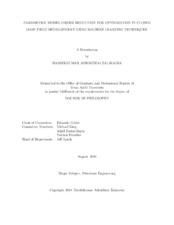| dc.description.abstract | Field development workflows consist of production optimization and data assimilation procedures that require running large number of reservoir simulations for fine scale models. Recent advancements in parallel computing and accelerated solvers have reduced simulation times for such high-fidelity models, however, repeated simulations and underlying complex non-linearities involved in multiphase and multicomponent models still remain a bottleneck. This computational challenge has motivated the development of Model Order Reduction (MOR) techniques which provide low dimensional representation of high-fidelity models and thus provide significant computational savings with the efforts to preserve the accuracy of simulation outputs. The aim of my research is to develop projection based MOR workflows for optimization problems in closed loop field development procedure, which include well control optimization and well placement optimization. We pose the problem formulation as Parametric Model Order Reduction (PMOR) that allows for taking into consideration a system parameter for each optimization problem considered. For developing Reduced Order Models (ROMs) for such problems, we use projection based Proper Orthogonal Decomposition (POD) which enables representation of reservoir state variables in terms of highly reduced set of variables. First part of the research is based on developing ROMs for well control optimization problem, where we look for the optimal strategy to control the wells settings. Here we use DEIM in addition to POD for quick evaluation of non-linear functions. We introduce a novel training procedure for global ROM during control optimization, which proved to give accurate results when compared to optimization using fine scale simulations. We test the performance of POD-DEIM for different optimization parameterization methods like polynomial and piecewise polynomial approximations on a waterflooding scenario. Polynomial approximation of BHP control served as good training sets for POD-DEIM with the training strategy proposed leading to accurate and fast reduced model. The second part of my research, which is a major contribution of my work, is based on developing ROMs for changing well locations during well placement optimization problem. Here, we do not employ proposed MOR on well location optimization problem, rather develop MOR strategies as a precursor to be used for well location optimization in future. Projection based reduced order modeling methodologies for well control optimization have reached a good level of maturity, however, MOR development for changing well configurations, is unexplored. We first propose error based local PMOR for new well location using a Machine Learning (ML) framework with POD. ML algorithms like Neural Networks and Random Forests help us predict the ROM error that eventually will choose appropriate basis at a new well location from previously computed reduced models.
We introduce geometry based features and physics based flow diagnostics features to train ML models. In efforts to tackle the issues with local PMOR technique proposed, we introduce a novel global non-intrusive PMOR technique based on machine learning. The idea here is to represent the entire parameter space of well location by a single global ROB and then using ML model to establish a relation between the input well location information and the POD basis coefficients of each state. We then also formulate the error correction model based on the reduced model solution, to account for solution discrepancies. The proposed method, that can make use of parallel resources efficiently, shows promising results on waterflooding case studies in predicting various quantities of interest (QoI) at new well locations such as oil production rates and water cut, and showed significant speedups of one to two orders of magnitude for the test cases. | en |


